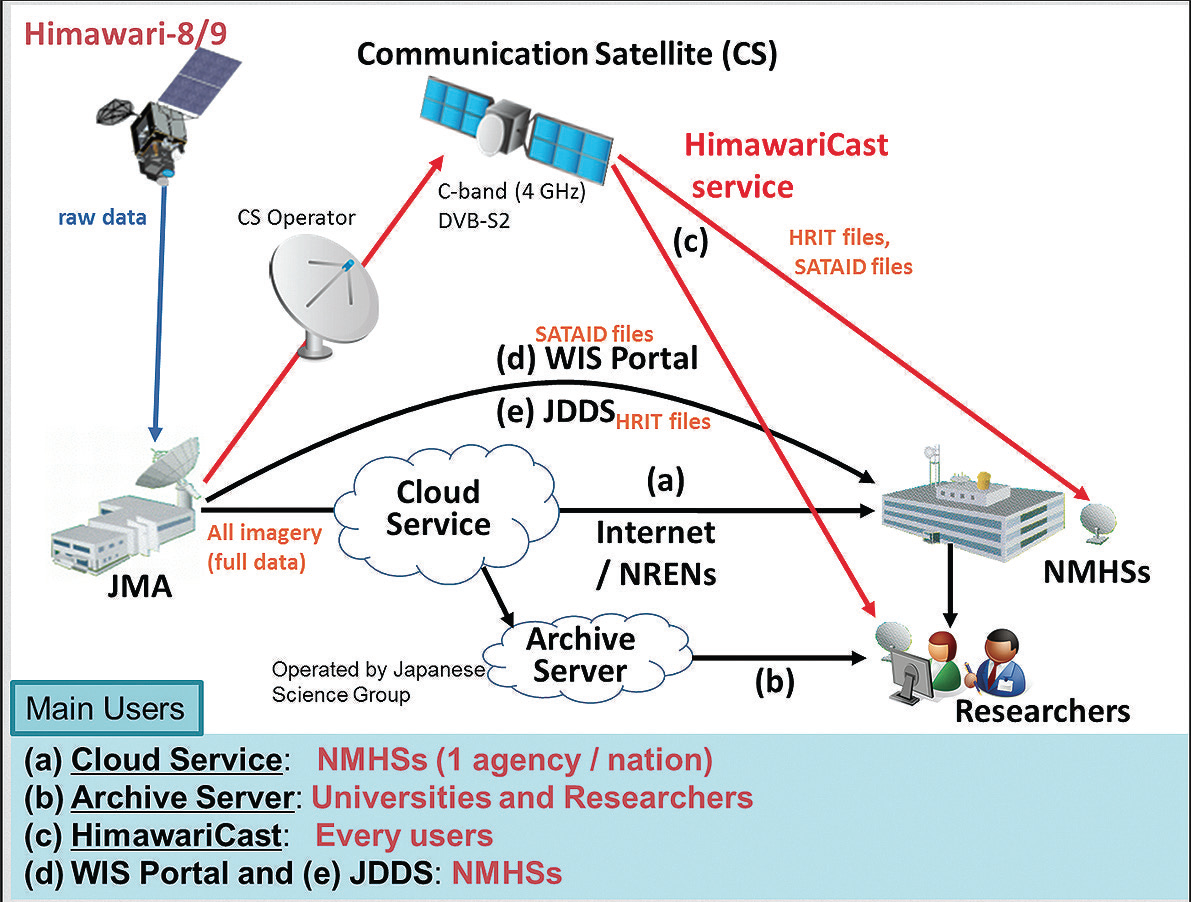Himawari-8 is the world’s first next-generation geostationary meteorological satellite. This year the Japan Meteorological Agency (JMA) deployed Fazzt data delivery from KenCast to use for their new HimawariCast service in order to disseminate the improved meteorological satellite data.

Artistic rendition of Himawari-8 and -9 satellites.
The JMA has been operating satellites and making related contributions to world meteorological “intel” since 1977 and is migrating to next generation satellites and data dissemination. Along with improved images for better weather prediction and environmental monitoring, a data delivery platform was required with attributes to support the migration and data dissemination with maximal reliability and global access:
• Data delivery packaging and sending via satellite multicast with automation features
• Data delivery reception with automation, easy acquisition and implementation
This article examines why KenCast’s Fazzt delivery system was selected by the JMA, what the components of the Fazzt system are, how they were actually implemented, and then assesses the results, those being the reliable and easy distribution and consumption of the HimawariCast data. Additional details regarding the JMA’s and others’ meteorological services is also included in this article.
New Satellites and Data Delivery
The new Himawari-8 and 9 satellite observations will provide more frequent and better imagery, and will do so every 10 minutes, to improve accuracy and usefulness of data. The new Himawari (which means “sunflower” in Japanese) satellites will succeed the MTSAT 1R and 2. Higher spatial resolution, more spectral bands (VIS (including color), NIR, and IR) as well as even more frequent observations around Japan (every 2.5 minutes) are features leading to better weather measurement, prediction and environmental monitoring.
The JMA’s HimawariCast service will transmit existing MTSAT originated LRIT and HRIT files which were being provided directly through the L-band frequency and new Himawari-8 data. Rather than send this data directly, MTSAT and Himawari-8 imagery will be distributed on communications satellites, called JCSAT 2A and 2B. Additional spectral bands will be sent for Himawari-8 (14) as are now sent for MTSAT-2 (5).

Overview of Satellite Observations
Selecting KenCast Fazzt
When planning for the HimawariCast service, packaging and datacasting of meteorological satellite imagery and related products from MTSAT2, Himawari-8 (and later Himawari-9) called for a trusted system from an established vendor with a track record in the business for reliability, flexibility and programmability to make the project efficient and effective. Having a local integrator with experience in the technology to manage the project was also preferred by the JMA.
Rikei Corporation, headquartered in Tokyo, Japan, a technology solutions company with more than 50 years in business and with 15-plus years of experience in broadcasting and satellite communications systems, had partnered with KenCast over the past 10 years on a number of satellite and other communications projects. The relationship with KenCast and product knowledge of the Fazzt Digital Data Delivery System were well established.
Considering that GEONETCast Americas, a service managed by NOAA (National Oceanic & Atmospheric Agency), the agency’s broadcast stream that covers the Americas, already used KenCast Fazzt for their data dissemination, the company seemed to be the natural candidate for this project. NOAA is the satellite data provider for GOES, POES and NOAA-NESDIS (National Environmental Satellite, Data and Information Service) atmospheric and marine data products.
The JMA provides access to the data as a free service to users within the multicast footprint. This means that the receiving technology would need to be affordable, as well. Recipients with the correct satellite reception equipment and a Windows PC can purchase suitable Fazzt client software for a moderate price.
Fazzt and the HimawariCast Service
The components for the solution included:
• KenCast’s Fazzt Enterprise Server
• Custom Fazzt Server Scripts
• The Fazzt Professional Client
• Custom Fazzt Client scripts
• JMA’s file manipulation program

Overview of Himawari-8/9 data distribution/dissemination.
KenCast’s Fazzt Dual Node Enterprise Server provides resilience and easy maintenance through load-balanced, self-healing, fail-over design. The Fazzt Enterprise Server™ software with Fazzt FEC® (Forward Error Correction) drives satellite multicasting with a variety of features to simplify and manage the process.
The HimawariCast solution used a hot folder-like feature in the Fazzt software, where files are dropped into a given folder automatically and are transmitted with a given set of parameters. This, together with Fazzt scripting, enabled an automatic workflow where weather data uploaded to the Fazzt Server via FTP into given folders were automatically processed and delivered without human interaction. The processing of the weather data involved multiple components, all native to Fazzt...
• Real time prioritization of data: Based on the urgency of the information to be transmitted, Fazzt was configured to pause transmissions of less important data in order to immediately send urgent data
• Fazzt FEC Protection: All files were encoded with Fazzt FEC, facilitating reliable delivery (allows for reconstructing on arrival for any loss or corruption, and validating accuracy)
• Automatic Cleanup Tasks: Any “obsolete” or old data was scheduled to be deleted using the built in Fazzt Scheduler
• SNMP Monitoring: While Fazzt provides full feature alarming with email and SNMP traps, JMA had requirements such that custom traps were created to allow for simpler monitoring of the server
Work on custom scripts for transmitting and receiving started in the second half of 2014, while implementation and testing began early this year. Rikei, on behalf of the JMA, has worked closely with KenCast throughout the project, providing specifications, testing and feedback.
The Fazzt Professional Client provides the following functions:
• Fazzt FEC Decoding: Decode received data to repair potential lost packets during transmission and validate file integrity compared
to original
• Process Image Data: Using Fazzt scripting, incoming files are decompressed and a call is made to JMA programs that prepare the received images for display

Overview of HimawariCast system structure.
The JMA file manipulation program and custom Fazzt scripts will be provided , at no cost, through the JMA infosite. For additional details, please refer to the JMA website links listed at the close of this story.
HimawariCast with Fazzt: Effective and Efficient
In summary, the Fazzt solution enabled the automatic and reliable delivery of JMA satellite data, together with integration into the JMA application on the receiving end. The project, which requires management of as many as 100 files every 10 minutes, 24 hours a day, every day, would be difficult and expensive for staff to consistently perform manually. Having a delivery system with integrated scripting able to manage data and call other routines made the accurate, timely and affordable distribution of data possible.
The JMA is meeting their mission to support the improved meteorological services made possible by the output of improved sensors of Himawari-8 and -9, and make that data available and useful to those seeking coverage of the East Asia and Western Pacific regions, while continuing access to the output of their predecessor MTSAT series. As with GEONETCast Americas, no registration is required and users may simply tune in to the datacast, although registration at the website is possible in order to receive updates by email.
“We’re happy to be part of the JMA’s system to improve meteorological services in weather forecasting, climate monitoring, natural disaster prevention and safe transportation,” said KenCast CEO, Bill Steele.
“The JMA hopes the HimawariCast service will be widely used and contribute to disaster risk reduction in the Asia Pacific region,” said KUMAGAI Yukihiro, Satellite Program Division, JMA.
Links for additional information on HimawariCast, KenCast, and GEONETCast Americas
www.data.jma.go.jp/mscweb/en/himawari89/himawari_cast/himawari_cast.html
www.kencast.com/solutions/geonetcast
www.geonetcastamericas.noaa.gov/

Dan Delventhal is the Director of Sales and Marketing for KenCast, Inc. Prior to joining the company in 2013, Dan was Vice President of Business Development at RecoveryPlanner.com, a leader in business continuity planning and management software and consulting. Previously, he was CEO at CONNECTapps.net, a hosting and IT solutions company he founded and later sold to employees. You can contact Dan at ddelventhal@kencast.com.
Since 1994, KenCast is trusted by the Hollywood movie studios, military and government agencies, major news networks, retail businesses and financial institutions to provide fast, secure and ultra-reliable delivery of multimedia content.
VazztPitcher - The Mobile File Broadcaster

Given the intense interest these days in the delivery of data to mobile devices, KenCast’s live streaming software—The VazztPitcher—sends and receives large data files and live streaming video across a wireless and/or wired network, all supported by maximum bandwidth.
VazztPitcher is next generation video and data streaming technology combines two of the company’s broadcast programs: the VazztCaster HD software program for streaming your live video, and the MBCaster software program that sends very large data files from the field. Both technologies have been used successfully by the military as well as by sports producers, entertainment and TV media, and by public safety agencies.
The VazztPitcher includes technology that receives the two broadcasts into a single program called the VazztHub—a transceiver that broadcasts point-to-point and/or multicasts. This combination can enable a multicast network or convert the one-way multicast network into a full two-way mesh network.
For more information VazztPitcher, contact KenCast at www.kencast.com/contact-us/inquiries/

